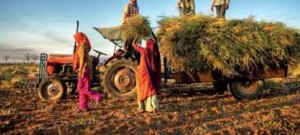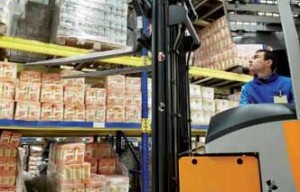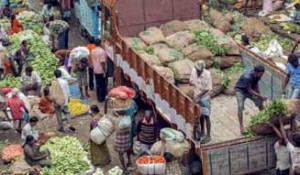In an exclusive interaction with Progressive Grocer, Director of Origo Commodities, Sunoor Kaul talks about how his company has been providing end-to-end solutions and ensuring efficiency and value creation for buyers and sellers at every stage of the commodity supply chain
Please offer a brief description of your company and the services it provides.
Origo Commodities offers complete commodity management solutions for farmers, farmer-producer organisations, and corporates. Its end-to-end solutions comprise procurement of agri commodities, commodity scientific storage and financing farm produce, while ensuring efficiency and value creation for buyers and sellers at every stage of the commodity supply chain.
Origo operates across three business verticals – procurement, warehouse management and collateral management. The company’s 1,000+ employees make for a strong workforce across the country, working with farmers, traders and processors. We are present in 14 states, reaching all constituents of agri industry.
Origo provides farmers the facilities to store, maintain and preserve their produce, to reduce wastage and thereby improve income realisation. Origo also provides warehouse receipt financing for meeting farmers’ working capital needs and addresses seasonality of income flows.
 What is your company doing to assist farm gate integration and efficiency?
What is your company doing to assist farm gate integration and efficiency?
Origo Commodities assists farmers in achieving higher profitability through farmer-producer organizations (FPOs) and primary agriculture cooperatives (PACS) in major aspects of agri-business, including access to better inputs, technology, procurement, storage, post harvest credit support, value addition and logistics.
Origo is also planning to launch integrated centres for purchase of agri produce and also for sale of inputs to farmers at the village level, thereby increasing the efficiency for farmers by bringing the buyer for their goods to their doorstep.
As India wastes 40 per cent of its produce before it reaches the shelf, the time is ripe for a revolution in food collection, storage and distribution in this country. Tell us about the initiatives of your company on these fronts and the impact they have had.
At Origo Commodities, we provide farmers and corporates with post harvest, agri solutions such as scientific storage facilities, quality certification and aggregation. For storage, we have created a mother hub which caters to satellite and local hubs. For example, if a farmer contributes two tonnes of produce, we aggregate 1,000 tonnes from 500 farmers with quality certification and this quantity is adequate for export cargo as well.
So our aggregation process is also a hand-holding exercise for farmers. We want to make them self-sufficient. By setting up FPOs and other initiatives, we have been able to provide significant benefits for farmers in terms of better input purchases and aggregation of produce for buyers.
 As per an estimate, the current spending on organised warehousing in India constitutes just 9 per cent of the total logistics spending as against 25 per cent in the US. What is holding back investment in the warehousing and cold storage space?
As per an estimate, the current spending on organised warehousing in India constitutes just 9 per cent of the total logistics spending as against 25 per cent in the US. What is holding back investment in the warehousing and cold storage space?
Warehousing in India is co-related a lot with real estate pricing and yield that the investor would make in developing that as a warehouse or a logistics park. At current prices of land, and without any government intervention or subsidies, investors have yields in low single digits. This is inadequate motivation for any investor to spend his resources in developing storage assets.
The government has yet to provide clarity related to the warehousing subsidy announced recently. The Government’s Grameen Bhandaran Yojana subsidy programme had offered support in terms of a certain portion of the development cost to those interested in investing in warehousing assets. But fiscal clarity on the same is lacking and thus the movement has slowed down as compared with the last few years. We hope that in the coming fiscal, the government will provide better clarity on the warehousing subsidy.
For many years now, food product transportation and storage has been a shambles with poor effectiveness to show for. In your opinion, what can the government and private players do to turn this scenario around?
There has been a rising awareness of the quantum of wastage resulting from the current food transportation and storage systems. This has been the impetus for the growing number of private players entering this arena to engage in public-private partnerships to
better the systems for all parties concerned. Today, Origo Commodities works with many government institutions in handling grains on behalf of FCI/ State Governments. Currently, Origo Commodities handles approximately 27 lakh metric tonnes rice, paddy and wheat for Pungrain on behalf of Food Corporation of India (FCI) in the state of Punjab.
Origo also works with the Punjab State Warehousing Corporation to manage grain handling at their warehouses. It is also in talks with many other state governments and state warehousing corporations to manage complete warehousing and grain handling operations for them.
 Since both the farm-end and retail-end have been fragmented for a long time, it is not surprising that we have such unplanned, and unreliable, post harvest and cold chain facilities. How do you see this trend changing in the future?
Since both the farm-end and retail-end have been fragmented for a long time, it is not surprising that we have such unplanned, and unreliable, post harvest and cold chain facilities. How do you see this trend changing in the future?
While the change has been slow, consolidation of supply chain in agriculture has started to happen. Origo is one of the agriculture commodity players that provides supply chain solutions for proper aggregation at farm level, allowing for greater efficiency in the system. Agriculture has been ignored as a business opportunity for a long time given the economics. But the scale of the sector allows for some players to leverage their pan-national capability to develop their economics to create a win-win situation for all constituents, including farmers, traders and consumers.
Most of the cold chain and warehousing capacity is concentrated in UP, West Bengal, Gujarat and Punjab. Given its profile, the investments in cold chain have been somewhat unplanned and somewhat skewed based on local knowledge and preferences. For example, about 75 per cent of the storage facilities are only suitable to store fresh vegetables and fruits, with temperature requirements in the range of 0° to 10° C. There is a similar skew in the refrigerated truck population, with 80 per cent of refrigerated vehicles being used to transport milk. Given this context, do you think that there is a compelling case for course correction in view of the new realities on the ground?
Cold chains have been focused in narrow geographical areas until recently. Given the
changing nature of business in agriculture of growing into a national platform, the opportunity for private players to leverage this gap is apparent. Some of them who have done it successfully are Snowman, which recently went public. Similarly there are other private players who are looking at this gap in cold chain as an investment opportunity.
Improvements in infrastructure, the visibility of agriculture production, arrivals data and digitisation of the whole agri ecosystem has a large role to play in bringing the focus to the sector and, in particular, the opportunities in this sector.
 What do you see as the major challenges affecting the supply chains of different agricultural commodities in India and what are the solutions?
What do you see as the major challenges affecting the supply chains of different agricultural commodities in India and what are the solutions?
Very often farmers deal with multiple challenges, which include financing and market linkages. In the existing supply chain, the major challenges for better price realisation for farmers are the produce financing (warehouse receipt financing), direct market accessibility and lack of storage.
The inability of farmers to monetise the produce post harvest either through warehouse receipt financing or having access to end consumer of their goods forces them to sell their goods to the first intermediary that shows up at their doorstep, at very low prices. This sale of goods, termed ‘distress sale’ leads to low price discovery on the harvest. While the APMC was structured to take care of this very requirement, their coverage has not been adequate. Also APMCs are not able to provide other services including financing on the
stock, which requires the services of collateral managers and financial institutions.
Another factor that prevents farmers from realising the right value of their produce is the value addition. Preliminary processing adds approximately 5-10 per cent to the sale price with minimal charges to the farmers. Farmers require a comprehensive ecosystem that will be able to derive the maximum value from their produce. An eco-system that includes scientific storage for safe keeping of the cargo, warehouse receipt financing, market linkage and preliminary processing, is essential for them.
Improvements in food procurement, transportation and storage face three challenges – capital, operating costs and talent. How do you envisage tackling these hurdles on the way?
In terms of capital, I believe that agriculture has been and will be an attractive area for investments for both equity and debt investments. It requires the entry of some organised players who can leverage the sector’s attractiveness with the availability of capital. So far agriculture has been treated as a less attractive industry to invest in due to low margins, high weather risk and fragmentation. At Origo we believe therein lies the opportunity. That is what players like Origo have done – increases the scale platform to make transactions, delivery and payments more robust and organised.
On operating cost, it is a challenge on scale. The more the scale, the less one would be concerned about overheads. Agriculture provides that opportunity for scale and for consolidation.
Talent is a concern in this sector. Earlier, high school children weren’t as excited to apply to agriculture colleges as they were for top-tier engineering or medical schools. Although there is the vast expanse coverage of agriculture and the focus on it, the trend has only slightly changed. I would say it is still not enough and talent remains a concern in the short-term, as well as long-term, till good talent is driven to agriculture as a preferred field of study.
 The cold chain industry in India is highly fragmented, with over 3,500 companies of various sizes operating in this space. What can be done to attract more “organised” players in this space?
The cold chain industry in India is highly fragmented, with over 3,500 companies of various sizes operating in this space. What can be done to attract more “organised” players in this space?
The government should encourage more PPPs for those interested in entering this segment, to effect change rapidly. Joint investment projects and greater intervention with subsidies for larger investments in the sector can only drive some of the organized players to enter into the segment, else the returns continue to remain the major deterrent.
How can there be a revolution in food collection, storage and distribution in this country when power shortages that rural India and small towns face are crippling?
The Government has been proactive in motivating investors and entrepreneurs to invest in solar power, while setting up cold storages which require continuous power supply. Subsidies provided by the government are higher and provide better yields to investors/developers.
 Bringing post-harvest solutions and cold chain infrastructure to rural India involves cost structures that are higher than what traditional providers of warehousing space are accustomed to dealing with. What is the way out then?
Bringing post-harvest solutions and cold chain infrastructure to rural India involves cost structures that are higher than what traditional providers of warehousing space are accustomed to dealing with. What is the way out then?
It is the scale of operations that come to rescue along with integration of multi-services leveraging the channel that agri players set up at the rural level. Delivering only one service can have a large weight on the cost and would render it unviable. The solution, along with scale, is to use the same channel for multiple services and again in case of agriculture, there are many opportunities for people to take advantage of.


